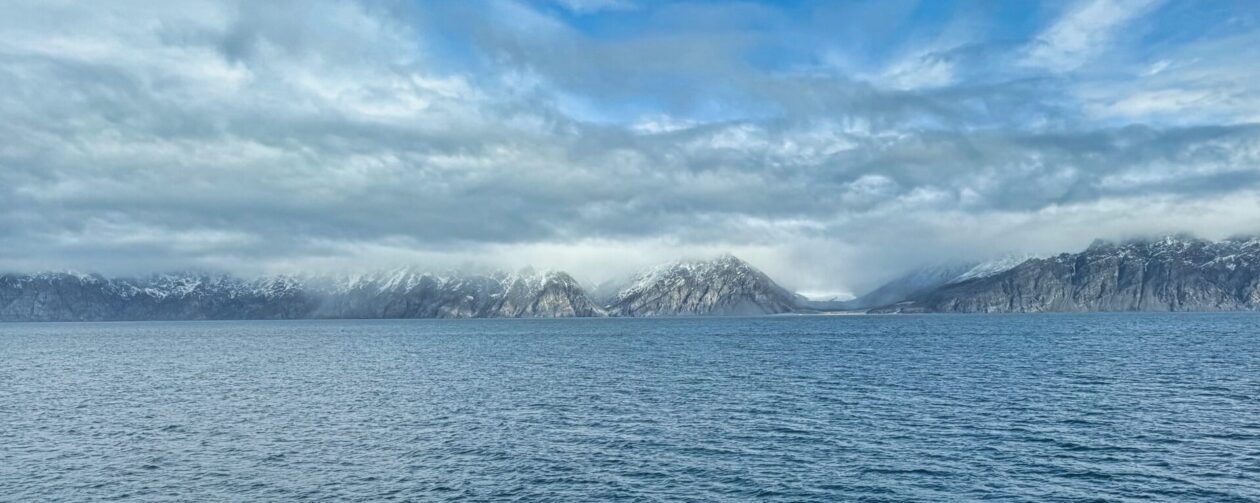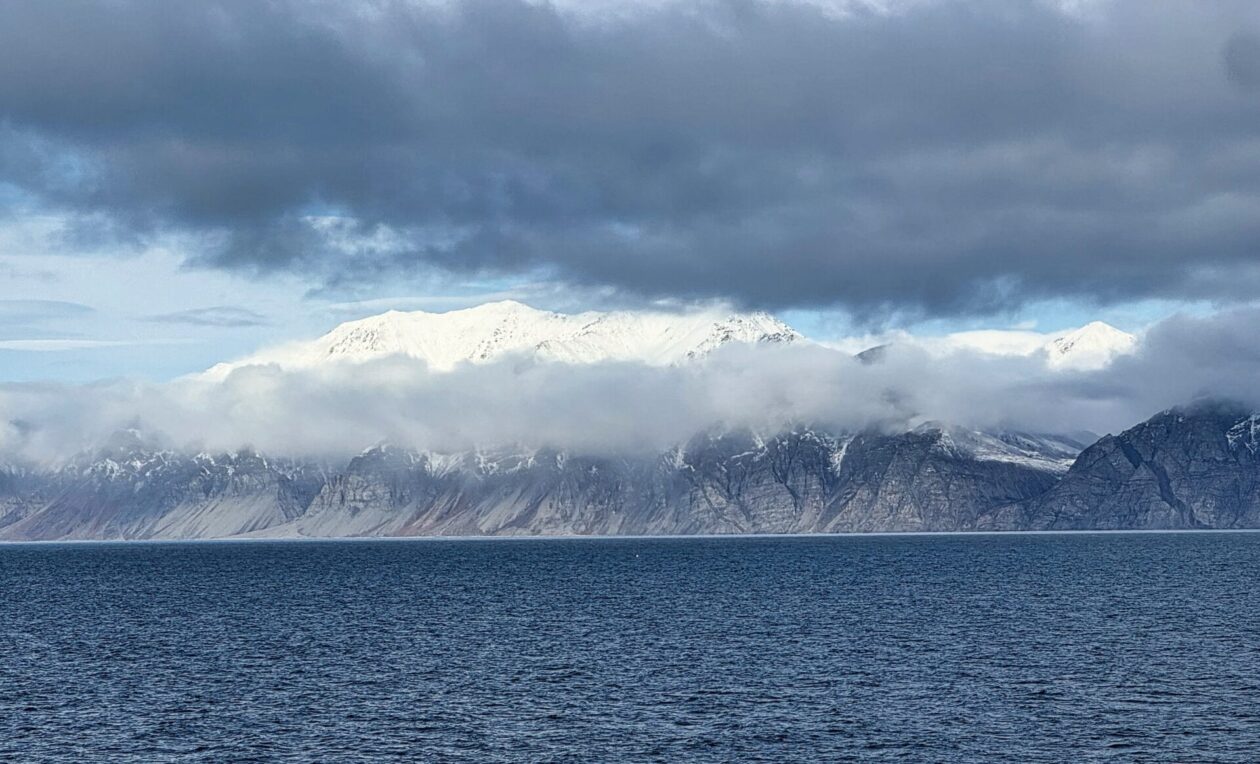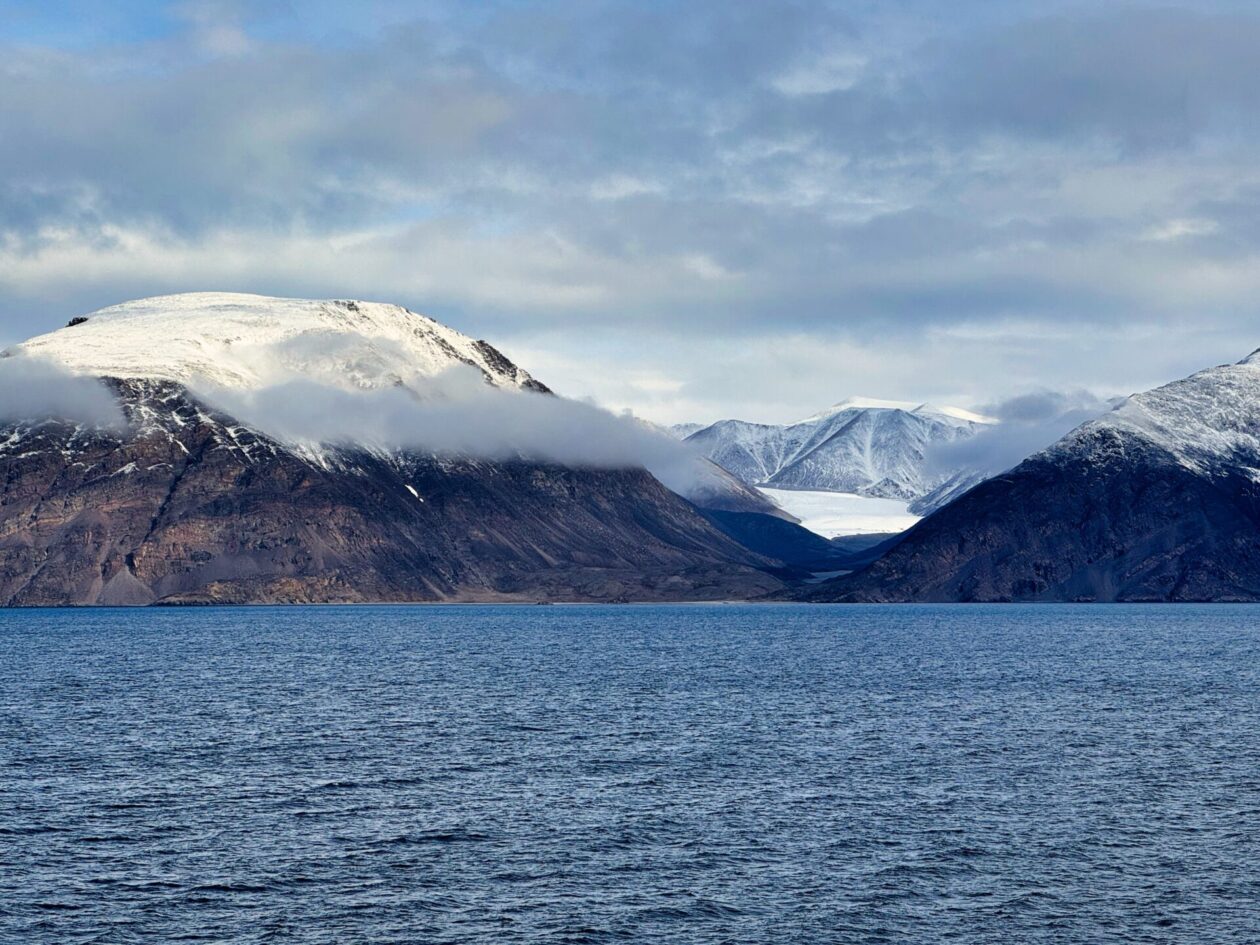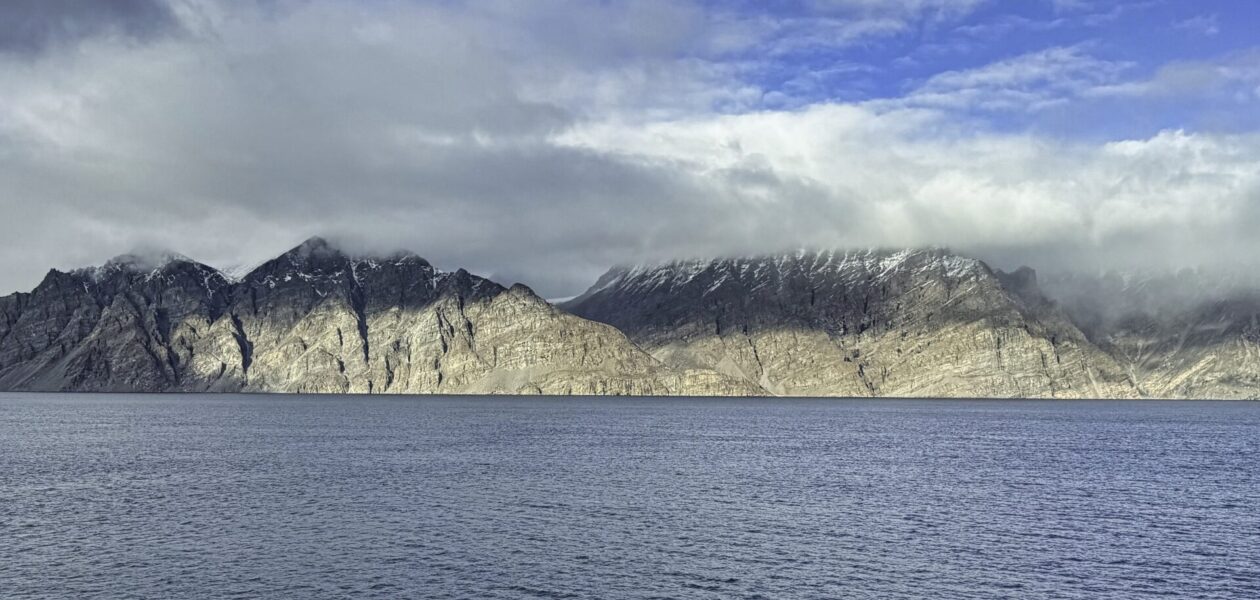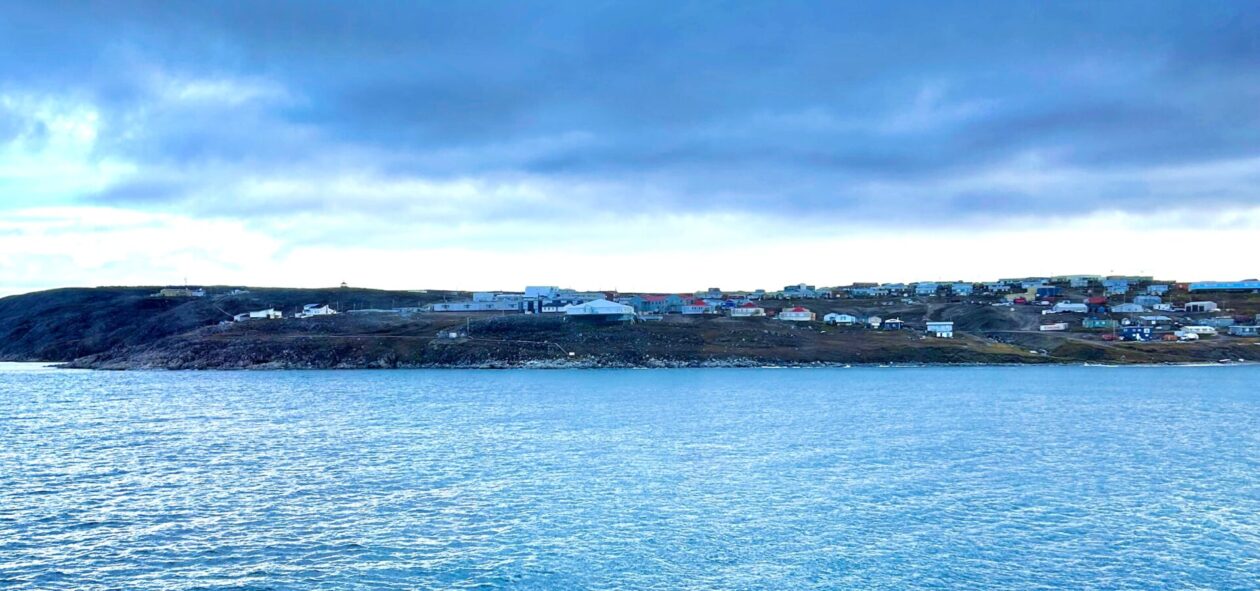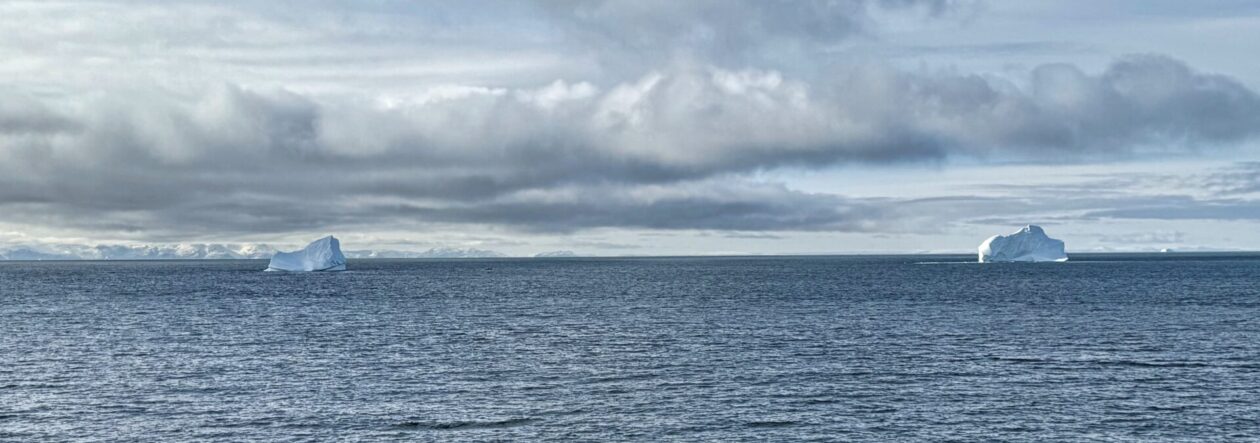- Start of trip and Nome, AL
- Herschel Island, Yukon, Canada
- Sea Day, a surprise, and the Smoking Hills, Northwest Territories, Canada
- Ulukhaktok, Northern Territories, Canada
- Murray Island, Nunavut, Northern Canada, Canada
- Cambridge Bay, Nunavut, Northern Canada
- Citizen science and Borge Island
- Gjoa Haven, Nunavut, Northern Canada
- A busy day at sea — polar bears, musk ox, and plankton, oh my!
- Prince Leopold Island, Beechey Island, and Radstock Bay, Nunavut, Northern Canada
- Croker Bay and Dundas Harbor, Nunavut, Northern Canada
- Pond Inlet and the Inuit, Nunavut, Northern Canada
- Ilulissat, Greenland
- Sisimiut, Greenland
- Red Bay, Labrador, Canada
- Corner Brook, Newfoundland, Canada and end of trip
Today, we traversed the Navy Board Inlet, a body of water that separates Bylot Island and Baffin Island. It was an absolutely beautiful transit with high mountains and glaciers on both sides. People just sat by the windows all day staring at the rugged beauty that surrounded us. Late in the afternoon, we cleared Customs at Pond Inlet, a predominantly Inuit community that is 600 miles above the Arctic Circle. This marks the eastern entrance to the Northwest Passage and, for our purposes, our departure from the Northwest Passage. We now have a couple of sea days crossing Baffin Bay before we arrive in Greenland. Given both their history and our interactions over the past few weeks, I wanted to share some thoughts about the Inuit people. This will be a little bit different than my typical blog post in that it is more an essay. For me, this trip through the Northwest Passage has been an education and an eye opener. And while we will come in contact with more Inuit in Greenland, I think the unique contributions and challenges faced by the Inuit, especially in Northern Canada are worthy of discussion.
Throughout this trip, I have gotten a whole new appreciation for the Inuit — the challenges they face, the support they have provided, and joy in how they live their lives. Since this cruise is focused on the exploration of the Northwest Passage, it became pretty clear that hubris doomed many expeditions — thinking they knew better than the people who have lived in this milieu for millennia. Those expeditions who were successful and/or those who were rescued can credit their lives to the Inuit. They have learned to not only live, but to thrive in this totally unforgiving environment. Initially migrating with the seasons, the Inuit have nearly all settled in communities these days. But the time honored knowledge gets passed down from generation to generation and both family and community are central to life. While today there is mandatory schooling, most of life’s lessons for the Inuit come from doing — how to hunt, how to smell game, how to harvest, and make use of every bit of an animal they hunt (e.g., how to sew the traditional parkas, mittens, and boots that keep you alive in this harsh environment). Rites of passage are important to the Inuit. For instance, when is a boy/man ready to marry? When he can build an igloo that could house a family and when he can successfully hunt. Those are the things that are necessary to sustain the lives of families and communities. And individuals are not only learning these skills for themselves, but also for the broader group because the expectation is that anything you hunt is to be shared with others: the elderly, those who can’t hunt, etc. If there is anything left over, it can be bartered for other things that are needed. And that fact is probably why Amundsen was appreciated over here. Not only did he respect and try to learn from the Inuit, he traded with them — especially things like metal that they could fashion into anything from hunting weapons to useful everyday tools like scissors. There doesn’t seem to be any bias across the Inuit community despite different languages, traditions, etc. as you span across Alaska, the provinces and territories of Canada, and Greenland. Each group is welcomed by the others. And, in fact, the Inuit welcome all people. There has been a lot of intermarriage, especially in the last several decades and when you marry into an Inuit family, you marry into the large extended family as well. You must care for, and be cared for by a large group of people. Even the naming of children is a very conscious act within a family. Relationships and authority don’t necessarily just follow traditional generational lineage. For instance, a child that is named for a deceased elder, at some level, assumes the elder’s place and responsibilities in the community and this is taken very seriously. And most importantly, the Inuit love to have fun, whether singing and dancing, playing Inuit sports, or have having big parties, especially after successful hunts.
But the Inuit have faced and continue to face huge challenges. As with other countries like the US, Australia, etc., the Canadian government relocated large numbers of Inuit to the very northern parts of Arctic Canada where the availability of game was limited. They also separated families, sent children away to schools, etc. While there may have been some good intentions associated with this, it was much more about convenience and control by the government over the people. When the government wanted the Inuit to start settling into communities rather than continuing to seasonally migrate, government agents would shoot their dog teams — which also limited their ability to reach places where their traditional game was located. And hunting and fishing provide for a major portion of their diet. This is both by choice and necessity. The Inuit view whales, seals, and even fish like Arctic Char as their traditional food and, as I mentioned earlier they eat all parts of these animals. Things like organ meats eaten raw provide the necessary vitamins and minerals to stay healthy; something many of the explorers never understood, resulting in their getting scurvy or starving to death. The Inuit consider this “country food” and, even when some Inuit move to the big cities with all their conveniences, they yearn for that traditional food. But there is also another imperative here — the outrageous prices for grocery items that people can buy in the co-op. Even when the Inuit are working for the government or small businesses, their salaries can’t nearly cover the cost of the food they need. As we saw on Ulukhaktok, this means that they buy on credit (their “tab”) putting them farther and farther in debt. A growing artistic culture and working with cruise lines that visit the area can add some incremental revenue, but it is still hard to make ends meet. Hence, traditional harvesting becomes the most realistic way to survive economically.And just a word on hunting whales, seals, etc.; while their is a great hue and cry by people who are against such practices, I think the criticism is appropriately leveled at countries like Japan, Norway, and Iceland because their hunts are for economic gain and, left unregulated, negatively impact the remaining stocks in the world. To the Inuit, these animals are giving the gift of their lives in order to feed and clothe a family and a community. The Inuit narrow their hunts to just that which they need to survive throughout the year. It has been and remains their heritage.
On this cruise, we have been fortunate to have a group of Inuit cultural ambassadors who have taught us a lot about their lives, language, traditions, beliefs, and challenges. They too suffer cultural appropriation which not only disrespects their unique cultural contribution, but also robs them from revenue that should be rightfully theirs. But they’ve also taught us the happy and fun sides of their lives like singing, dancing, and story telling. This has also prepared us for visits to the communities where we have had the opportunity to interact with the local people and avoid inadvertently causing hurt or uncomfortable feelings. We even learned to throat sing, which we demonstrated to the local people of Gjoa Haven to their amazement. I have to say that throat singing is probably the most compelling aspect of Inuit culture that has stuck with me over the years. I first saw it in a movie called “White Dawn” in 1974. It was at the same time compelling and eerie, taking a lot of focus and concentration. But I also learned that it is a game as well. To me, learning and experiencing indigenous cultures provides a key input for how I think about the world. So much of the culture in “developed” countries around the world has become homogenized and Westernized, popularizing trends and forgetting the roots that brought us to this point. Indigenous cultures teach us what is genuine — what is necessary to live, sustain, and be happy if often harsh conditions. The Inuit have certainly provided me some important insights on this trip, and for that I will be eternally grateful.
This entry was posted in Canada, Cruising, Northern Canada, Nunavut, Travel